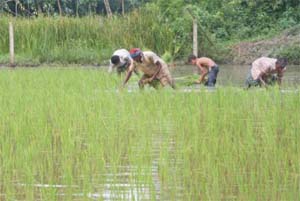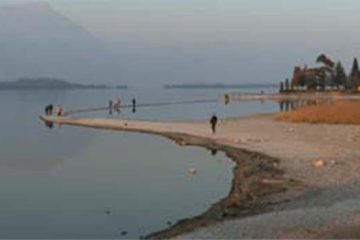Dr. Aminul Islam Akanda
 Bangladesh is blessed with suitable soil and climate for growing rice in all three crop seasons in a year. Rice grown during summer is locally known as Aus, during monsoon as Aman and during winter as Boro. The Boro is really the improved rice variety that is cultivated in almost all rice fields during winter. Winter rice is typically called Boro but is now cultivated in other seasons too. Gradual expansion of improved rice farming contributed much to total rice production increasing more than three times over the last three decades. The winter rice farming was a demand-led adoption by all types of farmers because of its higher productivity and it being produced in dry season almost in risk-free environment.
Bangladesh is blessed with suitable soil and climate for growing rice in all three crop seasons in a year. Rice grown during summer is locally known as Aus, during monsoon as Aman and during winter as Boro. The Boro is really the improved rice variety that is cultivated in almost all rice fields during winter. Winter rice is typically called Boro but is now cultivated in other seasons too. Gradual expansion of improved rice farming contributed much to total rice production increasing more than three times over the last three decades. The winter rice farming was a demand-led adoption by all types of farmers because of its higher productivity and it being produced in dry season almost in risk-free environment.
The development of mechanised irrigation system is considered as a key driving force for the development of this irrigated rice farming. In its early stage of adoption, winter rice occupied relatively more fertile soils relocating many winter crops to less fertile soils. Subsequently, it removed pulses, oilseeds and many other winter crops from many areas. Meanwhile, winter rice spread to three-forth of cultivated area in the winter, making up 54 percent of total rice production in the country.
Rice farming will remain occupying almost 75 percent of total crop area in 20 years ahead, as estimated from a trend analysis. Total crop area here is the sum of cultivated area in different crop seasons within a year. The cultivated area will continue to decrease because it being used for urbanisation and due to land-loss from river and coastal erosions. There is no room of increasing the total crop area because of natural barriers in multiple uses of many cultivated areas. In the year 2030, the rice farming will occupy 9.7 million hectares, which is lower than 11.2 million hectares at present. Even with a decrease in total crop area, a higher production is expected to be achieved because of technological improvement over time.
Rice yield is estimated at 4.5 metric tons (milled-rice) per hectare for the year 2030, which is 2.5 metric tons at present and this higher yield is achievable even under probable threats from climate change. Meanwhile, rice researchers have released disaster and salinity tolerant varieties yielding up to 4.5 metric tons per hectare. Moreover, Bangladesh Climate Change Strategy and Action Plan 2008 put emphasis on development of climate resilient cropping system. It is calculated that the country will produce 44 million metric tons rice in year 2030, against its requirement of 41 million metric tons to maintain current intake of 205 kilogram per person. It is to point out that current intake of rice is much higher than body requirement of 185 kilogram cereals that include rice, wheat and other grains.
The country uses 38 billion cubic meters water for producing winter rice at the rate of 1.9 cubic meters per kilogram. Recently, about 15 billion cubic meters is withdrawn from groundwater and the rest comes from surface water, soil moistures and atmospheres. If the same trend of rice farming continues, the winter rice production will reach 24 million metric tons and require 46 billion cubic meters water to produce in year 2030.
Meanwhile, the winter rice farming created huge pressure on groundwater, contributing 70 percent of total irrigation requirement which will reach at 91 percent in year 2030. The withdrawal of groundwater will relatively be higher under gradual lower contribution of surface water as water bodies would get dried. Winter rice farming will require 24 billion cubic meters of groundwater notifying an excess withdrawal of 9 billion cubic meters in 20 years hence. Incessant withdrawal of groundwater has appeared as threat visible from cracks on surface in northern region and from arsenic contamination in south-central part of the country. The groundwater stock is limited to only 23 billion cubic meters. Notwithstanding the fact that under-stream downward flow also contributes to groundwater stock, it would not contribute in future because of lifting groundwater almost everywhere.
Yet 44 percent of groundwater is economically non-viable for irrigation as reported by WARPO. Under this situation, required withdrawal will be higher than its withdraw-able stock during winter or dry season.
On-going concentration of rice farming will produce 44 metric tons in year 2030, but will require 37 million metric tons to produce for a balanced intake in the same year. Rather achieving an over-production at the cost of scarce water, some areas can be saved from rice farming over the next 20 years. In this journey, no excess water will be required for winter rice production and 8 billion cubic meters water can be saved from changing food habit. Moreover, gradual spread of Boro rice varieties during monsoon season can yield water-intensive rice in water abundant condition. The areas saved from winter rice faming can be brought back to other less water-intensive and diversified crops farming.
Earlier crop diversification efforts were not successful because the government incentives on irrigation, research and extension services were devoted to rice farming. However, it is necessary to reduce concentration on winter rice and to diversify crops with low water-intensive farming of oilseed, spices, potato and vegetables. Meanwhile, agricultural policies introduced demand-led extension service inspiring farmers to go for commercially important farming. It is a good news that vegetables grown earlier in winter has spread over all crop seasons and production also increased sharply.
Unless creating alternative demand for non-rice crops, any endeavour for reduction of rice and expansion of non-rice farming will not be effective. Now vegetables offer higher financial return compared to winter rice because of its higher price from higher demand. In the process of shifting toward non-rice crop farming, effective measures are necessary (i) to persuade people towards a balanced food habit, (ii) to diversify dishes from existing rice-curry based ones, (iii) to motivate children in primary education towards non-rice food, and (iv) to facilitate farmers with incentive for farming non-rice crops. A journey towards a balanced food basket thus can contribute to reduce concentration on rice farming, to expand non-rice crop farming and to achieve a water-efficient food production system in Bangladesh.
Dr. Aminul Islam Akanda is Assistant Professor, Department of Economics, American International University-Bangladesh, Dhaka



